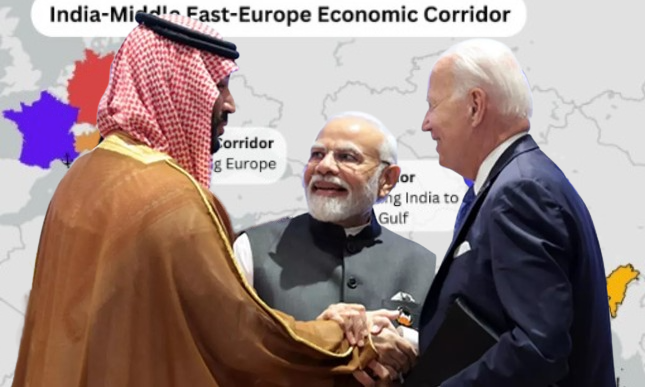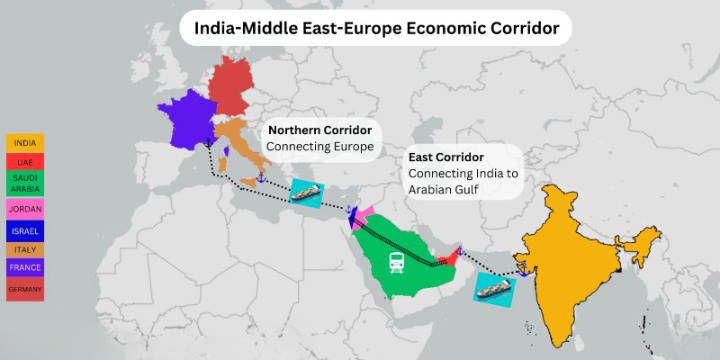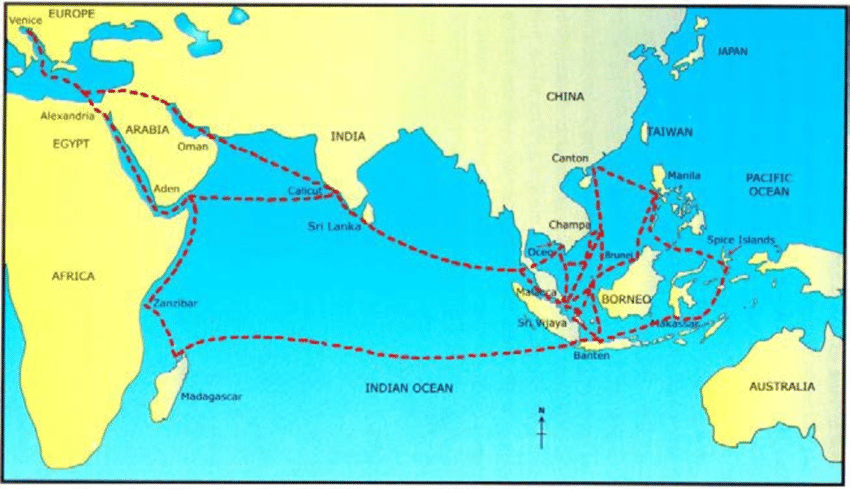The India-Middle East-Europe Economic Corridor supports the vision of initiatives such as Make in India, Sagarmala, and Aatmanirbhar Bharat. It paves the way for self-reliance by enhancing infrastructure in the logistics and transportation sector and developing significant capacities within Bharat.

In a world where connectivity is the lifeblood of economic progress, India is taking significant steps towards fostering enhanced integration and economic development, with the successful MoU signed on September 8, 2023, as part of the G20 Summit. The India-Middle East-Europe Economic Corridor (IMCC EC) is a visionary project that aims to strengthen connectivity between Asia, West Asia/Middle East, and Europe. This MoU has great potential to reshape the economic landscape of the region. This will be a breakthrough in post-Partition India’s quest for deeper connectivity with the regions to the northwest of the Subcontinent.
Evolution of the Corridor
The concept of establishing maritime and rail connectivity between India and the Arabian Peninsula first surfaced during a meeting between National Security Adviser Ajit Doval and his US counterpart Jake Sullivan in May of this year. Since then, this idea has gained significant momentum much more rapidly than initially expected.
India has long been concerned about China’s infrastructure projects in the region, as part of its decade-old Belt and Road Initiative. Additionally, India has faced exasperation due to Pakistan’s refusal to grant overland access, and its efforts to establish credible connectivity through Iran into the Eurasian landmass have been futile. However, India has now successfully devised a strategy to establish connections with both the Arabian Peninsula and Europe, while excluding non-ally nations.
The IMCC EC comprises two vital corridors.
East Corridor: This corridor connects India to the West Asia and Middle East regions. It’s a testament to India’s commitment to fostering economic ties with its neighbours and beyond.
Northern Corridor: Designed to connect West Asia/Middle East to Europe, this corridor creates an extensive trade network, promoting economic integration and cooperation.

The Power of Connectivity
At its core, the IMCC EC is all about connectivity. It introduces a rail line that will significantly enhance cross-border ship-to-rail transit, supplementing existing transport routes. This development promises to streamline the transhipment of goods and services between Southeast Asia, India, West Asia/Middle East, and Europe.
The project highlights a shift in geopolitical dynamics, revealing that India and the United States, which were once perceived as having limited common interests in the Middle East, have now forged collaboration in the Indo-Pacific and established the I2U2 forum with Israel and the United Arab Emirates to pursue joint economic ventures.
The India-Arabia-Europa corridor, emerging from this collaboration, has the potential to yield significant geopolitical consequences in the region. Furthermore, this initiative effectively ends Pakistan’s veto power over India’s land connectivity to the West. For decades, India has pursued various trans-regional connectivity projects involving Pakistan, but Islamabad consistently refused to grant India access to land-locked
Afghanistan and Central Asia
Despite its ongoing confrontation with the West, Tehran has displayed a more receptive attitude towards India. However, the viability of corridors through Iran into Eurasia is clouded by this geopolitical tension.
The establishment of this corridor will deepen India’s strategic involvement with the Arabian Peninsula. The Bharat government led by PM Narendra Modi, which significantly elevated its political and strategic ties with the United Arab Emirates and Saudi Arabia in recent years, now has an opportunity to establish lasting connectivity between India and the Arabian region.
During the era of the British Raj, the resources of the Indian subcontinent played a pivotal role in connecting India, Arabia, and Europe. The current project aims to restore India’s position as a driving force in shaping regional connectivity.
Additionally, according to U.S. officials, this mega connectivity initiative has the potential to reduce political tensions in the Arabian Peninsula by fostering intra-regional connectivity. The concept of “infrastructure for peace” has long been an enticing but elusive objective for the Middle East. It remains to be seen if this corridor can break that longstanding challenge.
The new corridor is openly presented as a potential alternative to China’s Belt and Road Initiative (BRI), which has garnered the support of numerous countries across South Asia, the Middle East, and Africa. Its success will largely hinge on the speed of its implementation and its ability to address the sustainability challenges—both financial and ecological—that have been associated with the BRI.
Notably, the corridor signifies Europe’s entry into infrastructure development in the region. The European Union had allocated 300 million Euros for global infrastructure spending during the period of 2021-27, and its backing of the new corridor positions the EU as a significant player in connecting India with Arabia and Europe through infrastructure projects. It can be noted that Italy, which became the only G7 country to join BRI in 2019 came out of it and now joined the Bharat-led India-Middle East-Europe Economic Corridor in 2023 during the G20 Summit. This is the future of global multi-modal economic connectivity.
Historical Roots of Connectivity
Long-distance trade had a profound impact on facilitating cultural, religious, and artistic exchanges among the prominent centres of civilization in both Europe and Asia during ancient times. While certain trade routes had been active for generations, as the first century A.D. commenced, merchants, diplomats, and travellers had the means to traverse the ancient world, spanning from the western regions of Britain and Spain to the eastern territories of Bharat Subcontinent, China, Japan and other South-East Asian Countries.
While the world is familiar with the ‘Silk Route,’ it’s now an opportune moment to resurrect the ‘Black Gold Route.’ Popularly known as ‘Black Gold’ in ancient times, – the Black pepper, one of the earliest commodities traded globally, played a pivotal role in shaping cultural, religious, and economic exchanges between Europe and Asia in antiquity. The spice routes established due to this trade were the precursors to modern globalization. During the Roman Empire’s reign, access to the Malabar Coast in India and its exotic spices was secured after their conquest of Egypt in 30 BC. Black pepper was so highly prized that it was demanded as part of a ransom to free Rome from the Huns, highlighting its immense value.

These ancient trade routes, developed over centuries, became the dominant pathways for pepper trade from the Malabar Coast to Europe for over 1,500 years. The Middle Ages saw pepper used as currency and gave rise to the saying “as dear as pepper.” Portugal’s efforts to break the Roman monopoly on the spice trade led to Vasco da Gama’s historic voyage to India, marking the beginning of Portuguese colonialism in India and the establishment of crucial spice routes that spanned Europe to the Far East.
Bharat’s commitment to connectivity is deeply rooted in its civilizational history, reviving the ancient multimodal routes. The nation has consistently sought to invest, cooperate, and build bridges with its neighbours, adhering to the principle of “Vasudhaiva Kutumbakam: One Earth, One Family, One Future.”
Consultative and Sustainable Development
Bharat recognises the importance of consulting all stakeholders and ensuring transparency and participation in connectivity initiatives. The nation places great emphasis on respecting the sovereignty and territorial integrity of all countries involved. Principles of financial responsibility, economic viability, and environmental sustainability are at the forefront of Bharat’s approach.
Unlocking Opportunities
The IMCC EC isn’t just about infrastructure; it’s about unlocking new opportunities for India’s industry and business sectors. By becoming a pivotal point in trade flows from Southeast Asia to the Gulf, West Asia, and Europe, Bharat gains a strategic and economic advantage. The corridor opens doors to the logistics and transportation sector, offering faster, cheaper transit options that boost trade and exports. Truly, the 21st Century is Bharat’s Century.
Green Transition and Economic Advantages
Bharat’s commitment to a green transition is bolstered by the IMCC EC. This corridor aligns with the nation’s green objectives, positioning it as a leader in the region. It secures supply chains, generates employment, and improves trade facilitation, thereby strengthening Bharat’s standing in the global arena.
A Vision for Self-Reliance
The IMCC EC supports the vision of initiatives such as Make in India, Sagarmala, and Aatmanirbhar Bharat. It paves the way for self-reliance by enhancing infrastructure in the logistics and transportation sector and
developing significant capacities within Bharat.
The Indo-Middle East-Europe Economic Corridor represents India’s ambitious vision for fostering connectivity, economic integration, and sustainable development. It is a testament to India’s commitment to building bridges, both literally and metaphorically, and stands as a symbol of hope for a more interconnected and prosperous future in the region and beyond. As India continues to play a pivotal role in this transformative project, it sets the stage for a brighter and more connected tomorrow.
Bharat’s G20 Summit, in the true spirit of “Vasudhaiva Kutumbakam” (the world is one family), has ushered in a new era of global consensus with its historic initiatives, including the Indo-Middle East-Europe Economic Corridor (IMCC-EC), the inclusion of the African Union as a permanent member of the G20, and the New Delhi Leaders’ Declaration.
(The author is a student of law and a communication professional. Her interests lie in governance, public policy & law and is part of the foundational batch of the Indian School of Public Policy, New Delhi)
